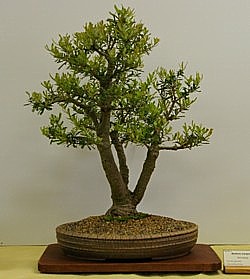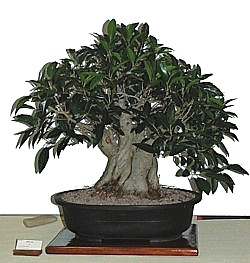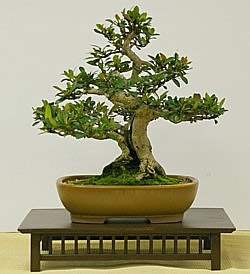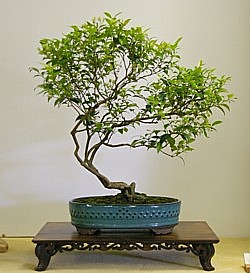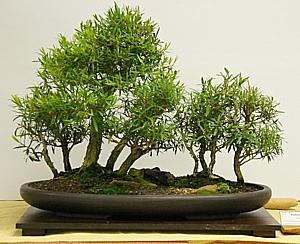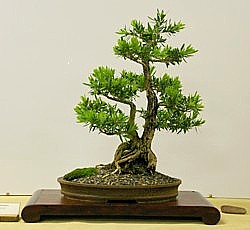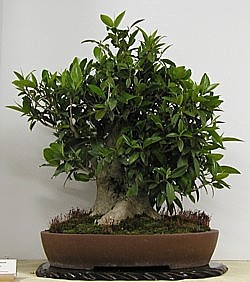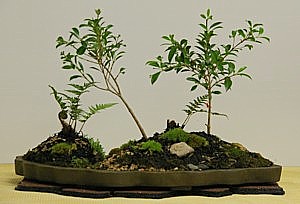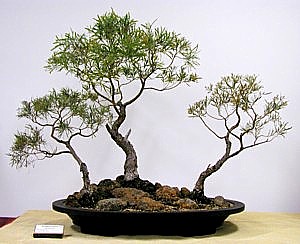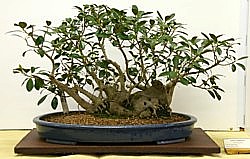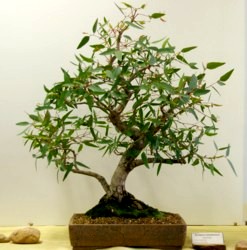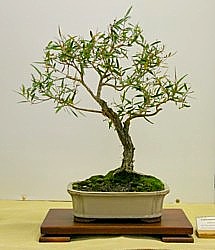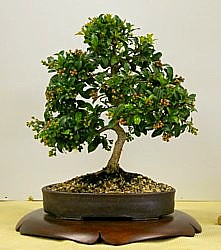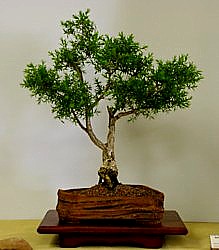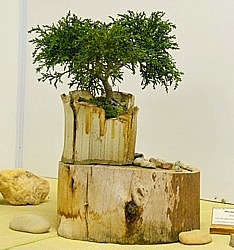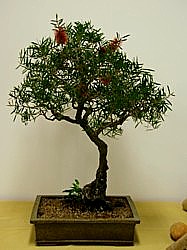Australian Native Plants as Bonsai - 2008
Catalogue Notes from the November 2008 'Australian Plants as Bonsai' exhibition
held at the Australian National Botanic Gardens.
Click on photo for larger view, and the "back" button on the larger photo page to return to this page.
Ficus rubiginosa The tree was bought as tube stock and has always been grown as a bonsai and always in a bonsai pot. Port Jackson figs develop a thick base if grown in a bonsai pot and the rest of the tree is a result of judicious trimming, wiring and shaping over the life of the bonsai. If the figs are well fertilized and healthy they can be defoliated at least once a year and this gives good ramification to the branches and also gives us small leaves. |
|
This tree was dug up as a two or three year old seedling near Wagga Wagga in 1999. In the field, the older trees can have branches hanging nearly vertically and a very wild appearance. The beautiful soft blue foliage is contrasted with the rough old looking bark on the trunk.
|
B.marginata is native to southeastern Australia and is the most frost hardy Banksia. Its growth form varies from dense compact shrubs in lowland regions to small trees in mountain areas. Leaves are also variable. This tree was obtained as young nursery stock in 2002 and grown in the ground for four years with some cutting back during this time. It was planted in a bonsai pot in 2006.
|
A South African demonstrator, Louis Nel, styled this tree at the AABC National Bonsai Convention in 2004. It is modelled on the flat top acacias that grow in the warmer parts of Africa. The tree was part of the Belconnen Mall plantings in 1976 and was 'rescued' in 2002 when the large planter boxes at Westfield Belconnen were being replaced.
|
The parent plant, L. morrisonii, grows on exposed rocky escarpments, slopes or on rocky creek banks or sandy alluvium, in the south east of NSW. 'White Opal' has pearly white flowers about 18 mm across. This specimen was acquired in 2002 as a three year old stock plant from a nursery. Its primary structure was largely created by harvesting cuttings.
|
Ficus sp. This tree was grown from seed collected in Ashfield Park in Sydney. It was grown for use as a bonsai because, as a full grown tree it would be too big for most backyards. I am not sure of the species but it is not a Moreton Bay or Port Jackson fig; perhaps it is a hybrid. This fig develops a large base with strong roots and aerial roots. It likes a warm sunny spot along with good drainage, as it is susceptible to root rot in poorly drained soil. Figs thrive on a regime of regular fertilising, watering and pruning. Native figs do not like the cold and growth is very slow in Canberra compared to, say, Brisbane. Figs offer great potential as bonsai, being long lived, easy to train and very rewarding as bonsai. |
Tristaniopsis laurina Started from seed 15 years ago. The tree grew steadily for around 9 years and then it developed some rot in the trunk as a result from a cut not being sealed. So I decided to carve it out and went even further than the rot and hollowed out the trunk, creating quite a feature on the tree. I feel it has worked well and added some age to the tree. Tristaniopsis' foliage will greatly reduce through defoliation, which I carry out in summer. It has attractive bonze new growth and then through the season it matures to green. The bark also greatly contrasts from young maroon stems to a white mature bark which starts to peel away with age. Tristaniopsis have small yellow flowers but they aren't readily seen as a bonsai because of the constant trimming. I have successfully repotted the tree in either March or August. Ideally, it should be done on an annual basis. |
Backhousia myritfolia The tree started from nursery stock. Five years ago I realised there were beautiful, small, creamy-white flowers in early summer. It grows very well in only one spot in my garden where it is protected but receives morning sun. The flowers last about 3 weeks. After flowering I fertilise, prune and remove spent flowers. Backhousia is a large shrub or small tree to 7m high. The leaves are broad-lanceolate to 7 cm - distribution Qld, NSW - propagation from cuttings (ref: Australian Native Plants, Reed) |
Babingtonia pluriflora The plant was purchased as a metre-high, scraggly, water-deprived, ant-ridden, long-neglected bush. It was reduced to 25 cm, bare rooted, put in good, open, bonsai soil and its rehabilitation started. The first year was slow as it regained strength. It was given away and a year later swapped back. Its recovery was strong and it was repotted into a Mirkwood pot with a well-positioned rock to camouflage an undercut on the trunk. It is a joy with its red-tipped new foliage and stems, tiny leaves and beautifully textured trunk. |
Callistemon sp. The trees were purchased as heavily-overgrown, neglected tube stock. The major root prune was done by pulling the holding tray up from the ground plus several hours cutting the plastic tubes away from the roots. $20 for 12 trees - well worth the effort. With good soil and care they rallied to the challenge of being bonsaiied and make a lovely group setting, |
Callistemon The tree was a bonsai-nursery stock plant with two trunks. One trunk was reduced to improve the tree's balance and it was grown-on to develop branches and foliage pads. It was repotted from the training pot to a bonsai pot in September 2008 which revealed an interesting and well-developed nebari. It grew one flower this spring and will be encouraged to produce more next year. |
Ficus rubiginosa This tree began as part of an Albury/Wodonga bonsai club project in 1993. Each member was given a few first-year seedlings and asked to grow them as bonsai and report back each year to show the tree's progress and share cultivation techniques. This tree started as two seedlings planted together with roots entwined to produce a twin trunk tree. The seedlings were potted into a series of large pots and fed and watered heavily for a number of years to attain good trunk thickness, then branches were selected and trained. It was transferred to a bonsai pot about 2001. Medium and large leaves are regularly removed during the growing season to promote ramification and small leaf size. Other seedlings started at the same time, were grown in 100mm pots to create fine, mini-fig bonsai. |
Acmena smithii and Dicksonia antarctica I have only recently transferred these plants into the landscape tray, adapting the penjing "Landscape and Water" styling. As the Lilly Pilly and Dicksonia are native to the moist coastal gullies and rainforests of Qld, NSW and Victoria (plus SA and Tasmania for the Dicksonia) I have attempted to create this atmosphere in the landscape. Lilly Pillys produce edible fruit - which hopefully will emerge from the buds on these plants. The Dicksonia, even at this very young stage, has the soft brown hairs at the base of the fronds. |
Callitris glaucophylla This tree was collected near Wagga Wagga, NSW, in 1999. Along with other small trees collected, the tree was grown-on in a large pot. Continual pinching back of new growth has kept the foliage to a rounded shape. In 2004 the tree was planted into a bonsai pot (created by Pat Kennedy) and the lower branches were wired to give width to the canopy. More wiring was done in 2007, the lower branches to give more width and the higher branches to give a very old look to the tree.
|
Ficus rubiginosa "Little Ruby" was purchased in approximately 1995, as a small bonsai starter from Ray Nesci Bonsai Nursery. Since then the tree has been repotted into a larger pot as necessary. Over the years, styling has been of the clip and grow method. In autumn 2008, the original apex died and a side branch has taken over as the main apex. The tree was potted into a Pat Kennedy pot in 2006. The tree is over-potted at the moment; however I am hopeful the tree will grow to fit the pot. |
Kunzea ericoides When acquired, the foliage was sparse and the left trunk was much higher than the other trunks. The tree was repotted in August 2000 to allow for mass foliage growth. In 2002 the left trunk was pruned to its current height. The tree was potted into its Pat Kennedy pot in September 2004. Since then continual pruning and shaping has brought the tree into its present style. Spring and summer growth was pruned and autumn growth retained. |
Banksia integrifolia After being inspired by B. integrifolia in the 2002 show, I went looking for some material I could work with. I picked up this Banksia at the Queanbeyan Council Nursery as nursery stock in early 2003. Most of the basic shaping was achieved by the cut and grow method. It was potted into a bonsai pot in 2004. Since then it has undergone some structural changes and been placed into a Pat Kennedy pot. |
Eucalyptus nicholii Having worked with E. nicholii since 1995, I have found this variety to be excellent native material for most of the basic techniques in bonsai, although my designs are different to the traditional designs. Over the past 5 years I have collected several E. nicholii from various nurseries with the intent of one day creating a setting uniquely Australian. Influenced by the eucalypts growing in the rocky outcrops south of Cooma, I collected rocks from paddocks near West Wyalong and set about creating a design. This is the result. It was put together in early 2007 and has already changed in structure from the original concept. |
Ficus rubiginosa This tree was dug from private property on the southern NSW coast about 4 years after the devastating bushfires of 1952 had passed through. It had grown from a section of root that was protected from destruction by the fallen and partially burnt parent tree. For many years the tree was left to grow in a nursery container until about 10 years ago when it was potted into its first bonsai pot. It is only in the last few years that the scorch marks from its firey beginnings have disappeared. The parent tree was growing within about 50km of its southern most natural distribution. |
Ficus rubiginosa This tree was grown from a cutting in about 1992. The cutting was taken from one of the early specimens of the "Little Ruby" fig, which was first discovered - by chance - in 1987 |
Eucalyptus camaldulensis This tree is believed to be about 19 years old. It probably was first trained in the early to mid 1990's. It changed hands in 2003 and was retrained into its current form, though its essential structure remained much the same. My aim (and I believe that of the previous owner) is to achieve a typical river red gum style that is reminiscent of the sort of tree you'd see if you took a drive down the Murray or Murrumbidgee Rivers. |
Leptospermum petersonii This tree was neglected, starved and dry when it was purchased for $10 from an old nursery. It is still developing and with regular pruning will develop denser foliage pads but even now it imparts the airy Aussie-bush-tree feel to the foliage. This is one of the few times I feel an oriental pot looks right with an Aussie native. |
Babingtonia pluriflora This tree will improve with more time in training but its delicacy and depth of green make it a lovely bonsai. Potting from nursery stock to bonsai set it back hard and for several weeks it went backwards before revving up its motor to power on. The style can only be called Australian and reflects similar trees you would see in the bush. |
Banksia marginata This stock plant was given to me by a local nursery because it was hanging over the pot and no one would buy it. A bit of bonsai styling and growth and it won Champion Native Bonsai at the Sydney Royal Easter Show in 2005. |
Acmena smithii This was a 3-leaf, scrawny stock plant in 2004 and has come on very nicely. It flowers profusely and drops the filaments over every other tree within cooee. The fruit is reddish pink. The tree was repotted last weekend from an oriental pot to an Australian made pot and really proves that Aussie pots suit most Aussie trees better than Japanese or Chinese. |
Melaleuca styphelioides In 2006 this was a half-dead nursery plant with no soil in one half of the pot. After a year in a plastic pot I discovered a colony of curl grubs had set up residence and were eating the roots. I needed another pot and it so happened that I had just purchased one created by Roger Hnatiuk - it was meant for the tree. The tree is growing strongly but it still has a long way to go - with some carving I may be able to highlight the dead wood better. |
Kunzea ambigua A forest grouping, such as you might find near a stream. The canopy is thin, reflecting the drought of the past several years. The twisting branches tell of survival in a sometimes harsh landscape. This miniature forest comes from self-sown seeds from another K. ambigua that has since died from an unexpected drought-event. The setting has a distinctly Australian bush feeling. The pot. created by R. Hnatiuk, helps to evoke the harsh but still beautiful, bush environment. |
Diselma archeri D. archeri is an endemic Tasmanian conifer, growing as a small tree in high altitude rainforest and in moist alpine shrubberies in the west and southwest of the state. Here in this setting it is portrayed as occurring on a tall, outcropping, rock pillar. Those familiar with some of the Tasmanian landscape will find this setting evocative of the wild country that still typifies some parts of the island state. The pot was created by R. Hnatiuk, based on ideas of basalt columns |
Callistemon sp. Max Leversha gave me this Callistemon as an unnamed stock plant in 1984.
|
Photographs by Barry Brown, Graphic Designer, Australian National Botanic Gardens and selections from other photographers
![An Australian Government Initiative [logo]](/images/austgovt_brown_90px.gif)




